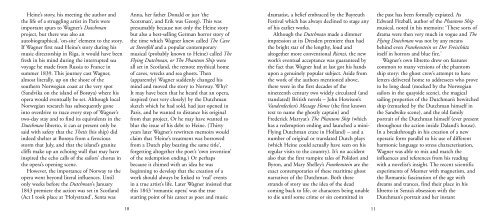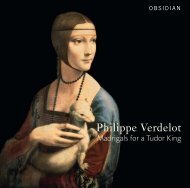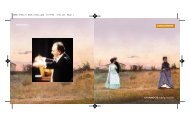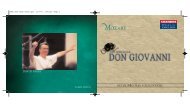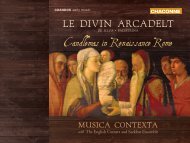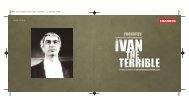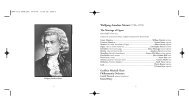CHANDOS
CHANDOS
CHANDOS
- No tags were found...
You also want an ePaper? Increase the reach of your titles
YUMPU automatically turns print PDFs into web optimized ePapers that Google loves.
CHAN 3119 BOOK.qxd 20/9/06 12:00 pm Page 10Heine’s story, his meeting the author andthe life of a struggling artist in Paris wereimportant spurs to Wagner’s Dutchmanproject, but there was also anautobiographical, ‘on-site’ element to the story.If Wagner first read Heine’s story during hismusic directorship in Riga, it would have beenfresh in his mind during the interrupted seavoyage he made from Russia to France insummer 1839. This journey cast Wagner,almost literally, up on the shore of thesouthern Norwegian coast at the very spot(Sandvika on the island of Borøya) where hisopera would eventually be set. Although localNorwegian research has subsequently goneinto overdrive to trace every step of Wagner’stwo-day stay and to find its equivalents in theDutchman libretto, it can at present only besaid with safety that the Thetis (his ship) didindeed shelter at Borøya from a ferociousstorm that July, and that the island’s granitecliffs make up an echoing wall that may haveinspired the echo calls of the sailors’ chorus inthe opera’s opening scene.However, the importance of Norway to theopera went beyond literal influences. Untilonly weeks before the Dutchman’s January1843 premiere the action was set in Scotland(Act I took place at ‘Holystrand’, Senta wasAnna, her father Donald or just ‘theScotsman’, and Erik was Georg). This waspresumably because not only the Heine storybut also a best-selling German horror story ofthe time which Wagner knew called The Caveat Steenfoll and a popular contemporarymusical (probably known to Heine) called TheFlying Dutchman, or The Phantom Ship wereall set in Scotland, the remote mythical homeof caves, wrecks and sea ghosts. Then(apparently) Wagner suddenly changed hismind and moved the story to Norway. Why?It may have been that he heard that an opera,inspired (not very closely) by the Dutchmansketch which he had sold, had just opened inParis, and he wanted to distance his originalfrom that project. Or he may have wanted toblur the issue of his debt to Heine. (Thirtyyears later Wagner’s rewritten memoirs wouldclaim that ‘Heine’s treatment was borrowedfrom a Dutch play bearing the same title’,forgetting altogether the poet’s ‘own invention’of the redemption ending.) Or perhapsbecause it chimed with an idea he wasbeginning to develop that the creation of awork should always be linked to ‘real’ eventsin a true artist’s life. Later Wagner insisted thatthis 1843 ‘romantic opera’ was the truestarting point of his career as poet and musicdramatist, a belief embraced by the BayreuthFestival which has always declined to stage anyof his earlier works.Although the Dutchman made a dimmerimpression at its Dresden premiere than hadthe bright star of the lengthy, loud andaltogether more conventional Rienzi, the newwork’s eventual acceptance was guaranteed bythe fact that Wagner had at last got his handsupon a genuinely popular subject. Aside fromthe work of the authors mentioned above,there were in the first decades of thenineteenth century two widely circulated (andtranslated) British novels – John Howison’sVanderdecken’s Message Home (the first knowntext to name the ghostly captain) andFrederick Marryat’s The Phantom Ship (whichhas a redemption ending and launched a mini-Flying Dutchman craze in Holland) – and anumber of original or translated Dutch plays(which Heine could actually have seen on hisregular visits to the country). It’s no accidentalso that the first vampire tales of Polidori andByron, and Mary Shelley’s Frankenstein are theexact contemporaries of these maritime ghostnarratives of the Dutchman. Both thesestrands of story use the idea of the deadcoming back to life, or characters being unableto die until some crime or sin committed inthe past has been formally expiated. AsEdward Fitzball, author of the Phantom Shipmusical, noted in his memoirs: ‘These sorts ofdrama were then very much in vogue and TheFlying Dutchman was not by any meansbehind even Frankenstein or Der Freischützitself in horrors and blue fire.’Wagner’s own libretto drew on featurescommon to many versions of the phantomship story: the ghost crew’s attempt to haveletters delivered home to addressees who proveto be long dead (mocked by the Norwegiansailors in the quayside scene), the magicalsailing properties of the Dutchman’s bewitchedship (remarked by the Dutchman himself inthe Sandwike scene), and the old familyportrait of the Dutchman himself (ever presentthroughout the action inside Daland’s house).In a breakthrough in his creation of a newoperatic form parallel to his use of differentharmonic language to stress characterisation,Wagner was able to mix and match theinfluences and references from his readingwith a novelist’s insight. The recent scientificexperiments of Mesmer with magnetism, andthe Romantic fascination of the age withdreams and trances, find their place in hislibretto in Senta’s obsession with theDutchman’s portrait and her instant10 11


